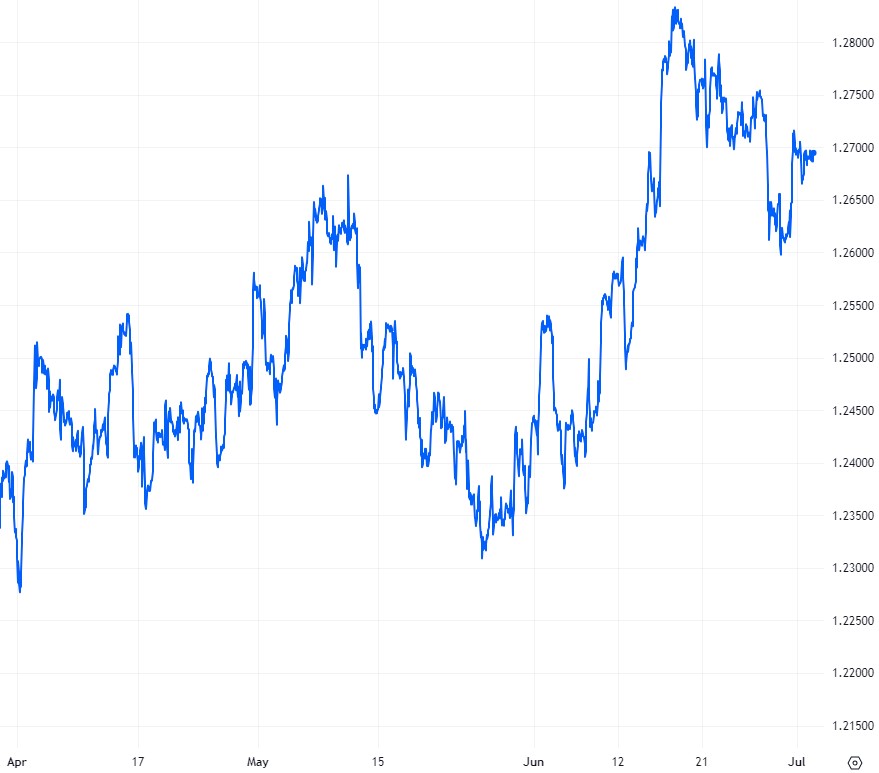GBP-USD Exchange Rate Surges by More Than 2% in June
The GBP-USD rate dropped sharply from three-week highs on 2 June following the release of hot US jobs data that boosted Federal Reserve interest rate hike expectations – but this was just a blip for the pair.
The pound gained traction on 6 June as upbeat market sentiment weighed on the safe-haven dollar – a mood that was stoked by mounting expectations of a rate hold at the Fed’s June meeting.
The GBP-USD pair began to shift through the gears on 8 June following the release of higher-than-expected US jobless claims, which printed at 261,000 – a sharp increase over the previous week’s 233,000.
Having jumped above the 1.25 benchmark, the pound continued to edge higher amid a diverging monetary policy outlook between the Bank of England (BoE) and Fed – with bets on hawkish action from the UK central bank lifting the UK currency.
Following a slight dip, the pound rebounded on better-than-forecast UK unemployment figures on 13 June. Unemployment levels dropped in April, surpassing forecasts for a rise in the number of people out of work. The print also revealed faster-than-expected wage growth, raising bets on a BoE rate hike in June and potentially August.
Meanwhile, the dollar was dented by US inflation data, which printed at 4% for the year to May 2023 – down from 4.9% in April and below the 4.1% forecast. The reading marked the lowest rate of US inflation since April 2021, further dulling Fed rate hike expectations.
As expected, the Fed paused its aggressive rate hiking cycle following its meeting of policymakers on 14 June – opting to hold its policy rate at 5.25%, before signalling that it would raise rates again.
Following a brief lull, the pound strode above the 1.28 benchmark on 16 June – hitting a 14-month high as markets bet on more BoE rate hikes while reining in expectations for the Fed.
The GBP-USD rate stagnated after hitting this high-water mark as it traversed the 1.28 range. With the pair appearing to have emptied its tank, the pound began to float lower against the dollar amid hawkish testimony from Jerome Powell. The Fed Chair indicated that the US central bank would take a data-driven, meeting-by-meeting approach to borrowing costs, with a future resumption possible.
A combination of faltering UK growth prospects and economic fears weighed on the pound before the BoE’s latest interest rate announcement dealt it a chastening blow on 22 June. The UK currency tumbled against the dollar – briefly dipping below 1.26 – after BoE policymakers voted for a greater-than-expected interest rate hike, prompting concerns of a UK recession.
Having settled in the 1.27 range, the pound achieved its biggest daily gain against the dollar in two weeks on 27 June, boosted by an attempted coup in Russia.
However, concerns that the UK is heading for a recession in the face of sky-high inflation and soaring borrowing costs soon resurfaced. This was compounded by a speech from Jerome Powell who promised at least two more US rate hikes – a hawkish tone that caused the pound to plunge to the depths of the 1.26 range.
GBPUSD: 3-Month Chart

Looking ahead
A fallow month for the BoE’s Monetary Policy Committee – the central bank’s panel of interest rate setters – means key economic data will be firmly in focus for the pound in July.
Influential data from the UK economy in July: Claimant Count Change (11 July), ILO Unemployment Rate (11 July), Consumer Price Index (19 July), Retail Sales (21 July), S&P Global Composite PMI (24 July).
The Federal Open Market Committee (FOMC) makes its next interest rate announcement on 26 July, with the US central bank widely expected to resume its rate hiking cycle.
Influential data from the US economy in July: ISM Manufacturing PMI (3 July), ADP Employment Change (6 July), Nonfarm Payrolls (7 July), ILO Unemployment Rate (11 July), Consumer Price Index (12 July), Producer Price Index (13 July), Retail Sales (18 July).






